Blackmagic Design Pocket Cinema Camera Users Manual
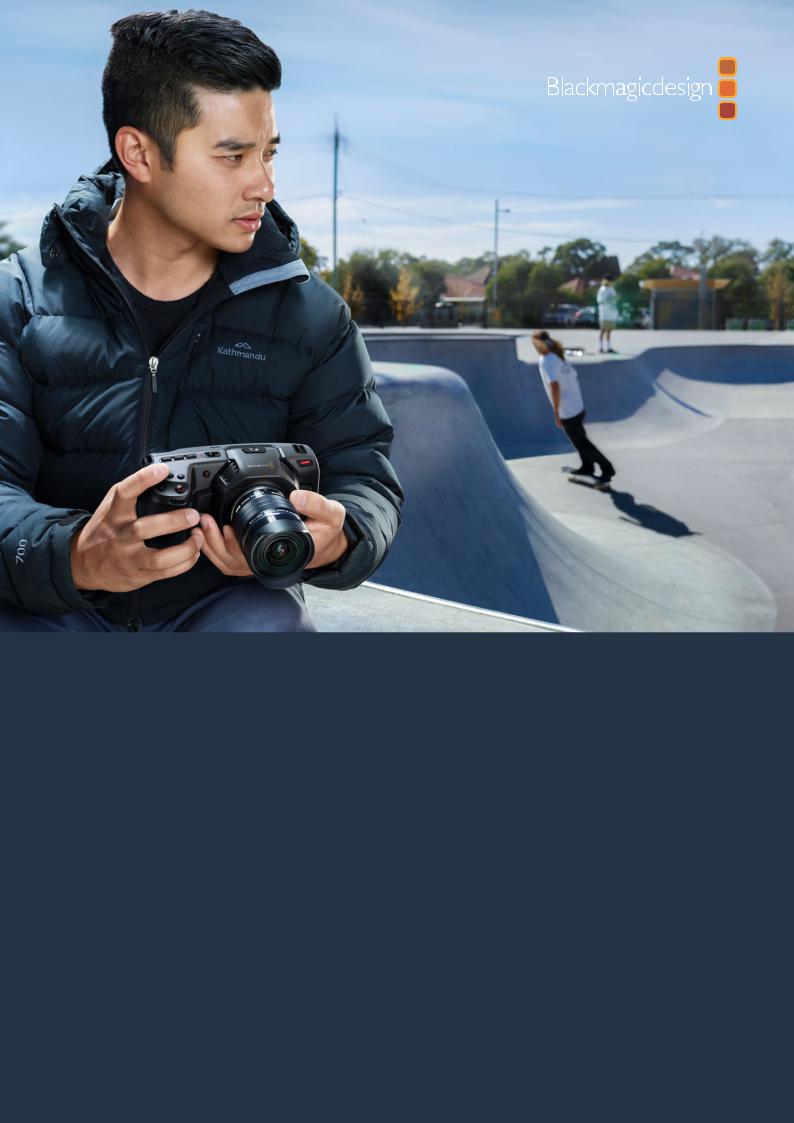
Installation and Operation Manual
Blackmagic
Pocket Cinema Camera
Includes Blackmagic Pocket Cinema Camera 6K and Blackmagic Pocket Cinema Camera 4K
August 2019

Welcome
Thank you for purchasing your new Blackmagic Pocket Cinema Camera!
In 2013, we released the original Blackmagic Pocket Cinema Camera. We were excited by creating a small camera with high dynamic range and groundbreaking image quality that you could take anywhere. After all your amazing feedback and being asked to make a 4K version, we decided to do exactly that and introduced Blackmagic Pocket Cinema Camera 4K in 2018. Now we are happy to introduce Blackmagic Pocket Cinema Camera 6K!
Blackmagic Pocket Cinema Camera 6K features a Super 35mm sized sensor and an EF lens mount. Blackmagic Pocket Cinema Camera 4K has the same Micro Four Thirds lens mount as the original Pocket Cinema Camera so you can use all your existing MFT lenses. Blackmagic Pocket Cinema Camera 4K records 4K video up to 60 frames per second and HD video at 120 frames per second on CFast or UHS-II SD cards. Blackmagic Pocket Cinema Camera 6K expands on these capabilities so you can also record 2.8K video at 120 frames per second and 6K video up to 60 frames per second! The USB-C port lets you record on external drives so you can unplug the drive from your camera and plug straight into your computer for an instant file workflow.
With 13 stops of dynamic range and dual native ISO, you can record beautiful, clean cinematic images in varying light conditions. The built in 5 inch LCD touchscreen lets you easily check focus and see fine details, even in bright daylight, and four built in microphones give you high quality audio straight into the camera!
Your Blackmagic Pocket Cinema Camera is made from a carbon fiber reinforced composite so it’s incredibly robust, very light, and easy to carry with you everywhere you go. Your camera can be powered via a standard LP-E6 battery, AC adaptor, or an external 12V DC source. We’re also proud to include our Blackmagic RAW codec, offering the flexibility of RAW processing all in a single file, providing massive performance increases with reduced file sizes.
We are extremely excited to see the creative work you produce using your new Blackmagic Pocket Cinema Camera, and look forward to your feedback on new features you would like to see added to your camera!
Grant Petty
CEO Blackmagic Design
Contents
Blackmagic Pocket Cinema Camera
Which camera are you using? |
|
4 |
Getting Started |
|
5 |
Attaching a Lens |
|
5 |
Turning Your Camera On |
|
6 |
Storage Media |
|
7 |
CFast Cards |
|
7 |
SD Cards |
|
9 |
USB-C flash disks |
|
11 |
Preparing Media for Recording |
|
13 |
Preparing Media on |
|
|
Blackmagic Pocket Cinema Camera |
|
13 |
Preparing Media on a Mac |
|
15 |
Preparing Media on Windows |
|
16 |
Recording |
|
17 |
Recording Clips |
|
17 |
Blackmagic RAW |
|
18 |
Recording to Blackmagic RAW |
|
18 |
Record Duration |
|
22 |
Playback |
|
26 |
Camera Features |
|
27 |
Camera Front |
|
27 |
Right Side |
|
28 |
Left Side |
|
28 |
Top Panel |
|
30 |
Camera Underside |
|
31 |
Camera Rear |
|
31 |
Touchscreen Controls |
|
32 |
Settings |
|
51 |
Dashboard |
|
51 |
Record Settings |
|
52 |
File Naming Convention |
|
57 |
Monitor Settings |
|
57 |
Audio Settings |
|
64 |
Setup Settings |
|
66 |
Presets |
|
74 |
3D LUTs |
|
76 |
Entering Metadata |
|
79 |
Slate |
|
79 |
Camera Video Output |
|
84 |
Using DaVinci Resolve |
|
85 |
Importing your Clips |
|
86 |
Saving Your Project |
|
86 |
Working with Blackmagic RAW Files |
|
87 |
Editing your Clips |
|
90 |
Trimming Clips |
|
92 |
Adding Transitions |
|
92 |
Adding Titles |
|
93 |
Color Correcting your Clips |
|
94 |
Using Scopes |
|
95 |
Secondary Color Correction |
|
97 |
Qualifying a Color |
|
97 |
Adding a Power Window |
|
98 |
Tracking a Window |
|
99 |
Using Plugins |
|
99 |
Mixing Your Audio |
|
100 |
Adding VFX and Compositing |
|
105 |
The Fusion Page |
|
105 |
Getting Started with Fusion |
|
107 |
Using the Motion Tracker |
|
|
and Adding Text |
|
110 |
Mastering your Edit |
|
113 |
Working with Third Party Software |
|
115 |
Working with Files from |
|
|
CFast 2.0 and SD cards |
|
115 |
Working with Files from |
|
|
USB-C flash disks |
|
115 |
Using Final Cut Pro X |
|
116 |
Using Avid Media Composer 2018 |
|
116 |
Using Adobe Premiere Pro CC |
|
117 |
Blackmagic Camera Setup Utility |
|
118 |
Developer Information |
|
119 |
Blackmagic Bluetooth Camera Control |
|
119 |
Blackmagic SDI and Bluetooth |
|
|
Camera Control Protocol |
|
121 |
Example Protocol Packets |
|
128 |
Help |
|
129 |
Regulatory Notices |
|
130 |
Safety Information |
|
131 |
Warranty |
|
132 |
3
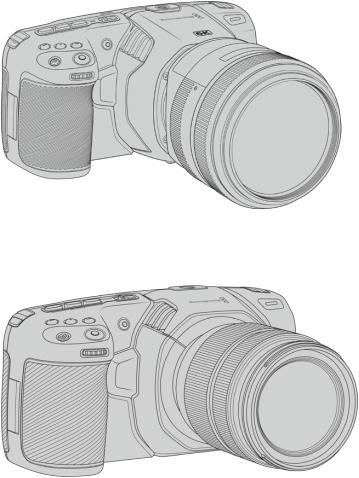
Which camera are you using?
Blackmagic Pocket Cinema Camera 6K and Blackmagic Pocket Cinema Camera 4K models have similar appearances. Both cameras produce incredible, wide dynamic range images and share the same chassis. The control buttons and software menus are laid out the same way, and operating the cameras is essentially the same.
Blackmagic Pocket Cinema Camera 6K features a Super 35mm sized sensor and an EF lens mount, and has a 6K icon above the lens mount. Blackmagic Pocket Cinema Camera 4K features a Micro Four Thirds sized sensor and a Micro Four Thirds lens mount.
Blackmagic Pocket Cinema Camera 6K
Blackmagic Pocket Cinema Camera 4K
Which camera are you using? |
4 |
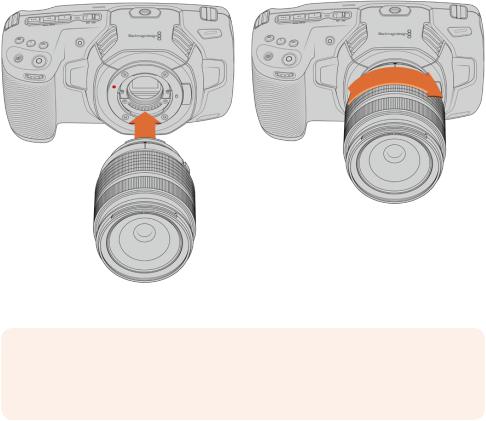
Getting Started
Blackmagic Pocket Cinema Camera is a small portable digital cinema camera that records high quality images on CFast 2.0 and UHS-I and UHS II SD cards or an SSD via the USB-C port. Your Pocket Cinema Camera is capable of recording clips using professional codecs designed for post production including Blackmagic RAW and ProRes.
Getting started with your Blackmagic Pocket Cinema Camera is as simple as mounting a lens and powering your camera.
Attaching a Lens
Blackmagic Pocket Cinema Camera 6K uses EF lenses and Blackmagic Pocket Cinema Camera 4K uses Micro Four Thirds lenses. Both of these types of lenses are very popular and affordable, plus there is an enormous range to choose from. Attaching a lens to your camera is the same process for Blackmagic Pocket Cinema Camera 6K and Pocket Cinema Camera 4K. In both cases, the first step is to remove the protective dust cap. To remove the protective dust cap, hold down the locking button and rotate the cap counterclockwise until it is released.
To attach an EF mount or Micro Four Thirds lens:
1Align the dot on your lens with the dot on the camera mount. Many lenses have a visual indicator, for example a blue, red or white dot.
2Press the lens mount against the camera mount, and twist the lens clockwise until it clicks into place.
3To remove the lens, hold down the locking button, rotate the lens counterclockwise until its dot indicator reaches the 10 o’clock position on an MFT lens, or 12 o’clock for an EF lens. Gently remove the lens from its mount.
Attaching an MFT lens on Blackmagic Pocket Cinema Camera 4K
NOTE When no lens is attached to the camera, the glass filter covering the sensor is exposed to dust and other debris so you’ll want to keep the dust cap on whenever possible.
Getting Started |
5 |

Turning Your Camera On
Now that you’ve attached a lens, you will need to supply power to your camera. Blackmagic Pocket Cinema Camera can be powered by inserting an LP-E6 battery into the camera, or by plugging the supplied power adapter into the power input.
Inserting a Battery and Powering your Camera
Your camera uses standard removable LP-E6 type batteries. One is included with the camera, but if you need additional batteries, they can be purchased from your Blackmagic Design reseller or from most video or photography equipment stores.
1On the underside of the camera, press the door release to open the battery door.
2With the contacts facing the terminal, insert the LP-E6 type battery until you feel it click into place under the locking tab.
TIP To release the battery, push the locking tab towards the front of the camera and the battery will eject.
3Close the door to the battery terminal and gently push until it clicks into place.
4Move the power switch on the top of your camera to the ‘on’ position. To turn off the camera, move the power switch to the ‘off’ position.
Powering Your Camera with the Included Power Cable
The included 100-240 volt plug pack can be used to simultaneously power the camera and charge the LP-E6 battery. The DC power connector locks to the camera so it cannot be accidentally disconnected.
To plug in external power:
1Connect the AC to 12V DC adapter plug to your mains power socket.
2Open the rubber protector on the left side of your camera and rotate the locking DC power connector so that it lines up with the recess on the top of the 12V DC power input. Gently push the connector into the input until it clicks.
3To unplug the connector, pull the sheath away from the connector and remove the connector from the input.
If you have both external and battery power connected, only external power is used. If you remove external power while a charged battery is connected, your camera switches to battery power without interruption.
Your camera’s LP-E6 battery can be charged via USB when the camera is switched off. This is convenient as you can use a portable power bank to charge the camera when not in use. Blackmagic Pocket Cinema Camera supports charging via standard 10W USB wall chargers and can also be used with chargers that support USB-Power Delivery, or USB PD. USB PD chargers typically have a USB-C connection and up to 20V output, so can provide a faster charge. Charging the LP-E6 battery via the 12V DC power input is supported when the camera is switched on or off.
TIP If charging a hot battery immediately after use, charging speed is reduced until the battery cools below 45 degrees C or 113 degrees F. We recommend letting the battery cool down for 15 minutes before charging.
You are now ready to insert the storage media and start recording!
Getting Started |
6 |
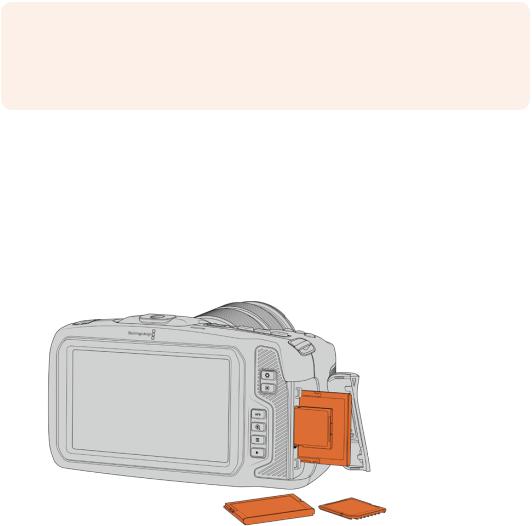
Storage Media
Your Blackmagic Pocket Cinema Camera uses standard SD cards, faster UHS-II SD cards or CFast 2.0 cards to record video.
Using the USB-C expansion port, you can also connect high capacity USB-C flash disks for increased recording times.
CFast Cards
CFast 2.0 cards are capable of supporting very high data rates, so are perfect for recording 6K, 4K and HD video at high frame rates. Refer to the record duration tables in the ‘recording’ section for details on the maximum frame rates that can be recorded in each format.
NOTE CFast 2.0 cards are generally high speed cards, though some cards have slower write speeds compared to read speeds, and maximum data rates can differ between models. For reliable recording with your chosen frame rates, use only the cards recommended by Blackmagic Design.
Inserting a CFast Card
To insert a CFast card:
1Open the side door on the right side to access the media slots.
2Insert the CFast card into the CFast card slot until you feel it lock into place. The card should insert easily without the need for excessive force. To remove a CFast card, gently push the CFast card towards the camera, then release to eject it.
The storage information at the bottom of the LCD touchscreen will show the name and record time remaining of the detected CFast card.
Choosing a CFast 2.0 Card
When working with high data rate video it’s important to carefully check the CFast card that you would like to use. This is because CFast 2.0 cards have different read and write speeds.
For the most up to date information on supported CFast cards on
Blackmagic Pocket Cinema Camera, please refer to the Blackmagic Design support center at www.blackmagicdesign.com/support.
Storage Media |
7 |
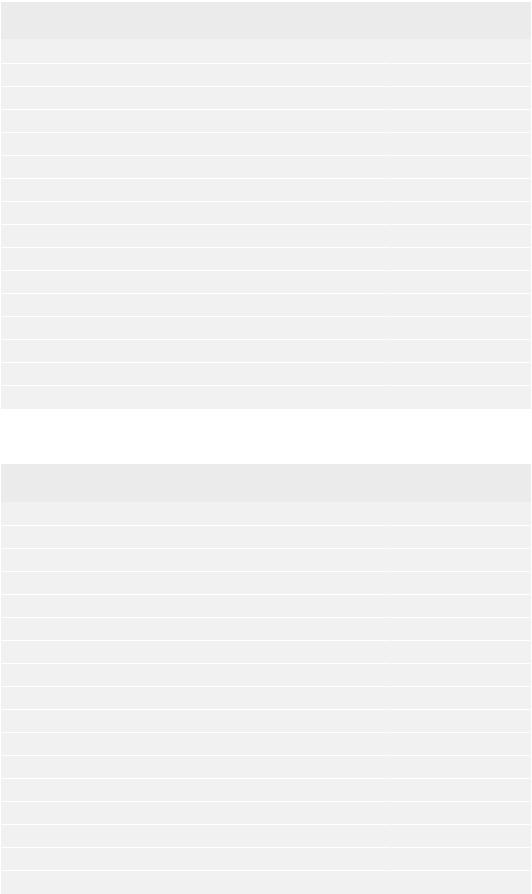
The following CFast 2.0 cards are recommended for recording 4K DCI Blackmagic RAW 3:1 up to 60 fps on Blackmagic Pocket Cinema Camera 4K.
Brand |
Card Name |
Storage |
|
|
|
Angelbird |
AV PRO CF |
512GB |
Angelbird |
AV PRO CF |
1TB |
CinediskPro |
510MB/s CFast 2.0 |
256GB |
Hagiwara Solutions |
DC-SMAN64GA CFast 2.0 |
64GB |
Hagiwara Solutions |
DC-SMANA1GA CFast 2.0 |
128GB |
KomputerBay |
3400x CFast 2.0 |
64GB |
KomputerBay |
3400x CFast 2.0 |
128GB |
Lexar |
Professional 3400x CFast 2.0 |
128GB |
Lexar |
Professional 3500x CFast 2.0 |
256GB |
ProGrade Digital |
550MB/s CFast 2.0 |
128GB |
ProGrade Digital |
550MB/s CFast 2.0 |
256GB |
ProGrade Digital |
550MB/s CFast 2.0 |
512GB |
SanDisk |
Extreme Pro CFast 2.0 SDCFSP-256G-x46D |
512GB |
Wise |
CFast 2.0 3400x |
128GB |
Wise |
CFast 2.0 3400x |
256GB |
Wise |
CFast 2.0 3500x |
512GB |
|
|
|
The following CFast 2.0 cards are recommended for recording 4K DCI ProRes HQ up to 60 fps on Blackmagic Pocket Cinema Camera 4K.
Brand |
Card Name |
Storage |
|
|
|
Angelbird |
AV PRO CF |
128GB |
Angelbird |
AV PRO CF |
256GB |
Angelbird |
AV PRO CF |
512GB |
CinediskPro |
510MB/s CFast 2.0 |
256GB |
Hagiwara Solutions |
DC-SMAN64GA CFast 2.0 |
64GB |
Hagiwara Solutions |
DC-SMANA1GA CFast 2.0 |
128GB |
KomputerBay |
3400x CFast 2.0 |
128GB |
ProGrade Digital |
550MB/s CFast 2.0 |
256GB |
ProGrade Digital |
550MB/s CFast 2.0 |
512GB |
SanDisk |
Extreme Pro CFast 2.0 SDCFSP-64G-x46D |
64GB |
SanDisk |
Extreme Pro CFast 2.0 SDCFSP-128G-x46D |
128GB |
SanDisk |
Extreme Pro CFast 2.0 SDCFSP-256G-x46D |
256GB |
Sony |
CFast 2.0 G Series CAT-G64 |
64GB |
Sony |
CFast 2.0 G Series CAT-G128 |
128GB |
Wise |
CFast 2.0 3400x |
128GB |
Wise |
CFast 2.0 3400x |
256GB |
Wise |
CFast 2.0 3500x |
512GB |
|
|
|
Storage Media |
8 |
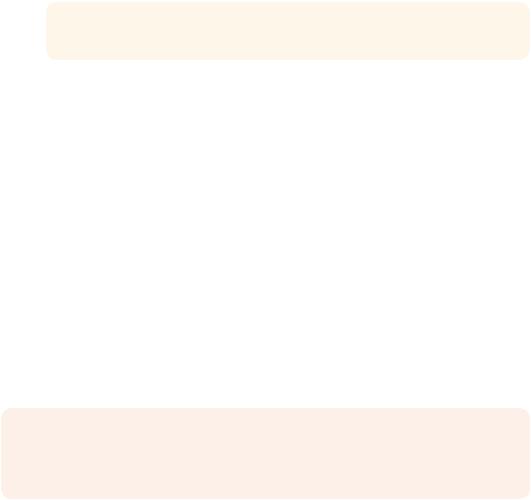
SD Cards
In addition to CFast 2.0 cards, your camera can record on high speed UHS-I and UHS-II type SD cards. UHS-I SD cards allow you to use more affordable storage media when shooting compressed video formats in HD, and even faster UHS-II cards allow you to record Blackmagic RAW as well as Ultra HD content in ProRes.
With SD cards, you can use more affordable storage media when shooting compressed video formats in HD.
SDXC and SDHC are a very common media storage format for consumer still and video cameras. If you’ve ever shot video using a DSLR, or use a Blackmagic Micro Cinema Camera, Pocket Cinema Camera or Blackmagic Video Assist, you may already have compatible
SD cards to use.
For projects that don’t require the highest resolution files, or for when long recording durations are needed, using SD cards can be very economical. Lower capacity and lower speed SD cards can also be used for storing and loading LUTs and Presets.
Inserting an SD Card
To insert an SD Card:
1Open the door on the right side to access the media slots.
2With the label on the SD card facing the touchscreen, insert the SD card into the SD card slot until you feel it lock into place.
TIP To eject an SD card, push the SD card in then slide it out.
The storage information at the bottom of the LCD touchscreen shows the name and record time remaining of the detected SD card.
Choosing an SD Card
If you are recording 6K, 4K DCI or Ultra HD, then then we recommend using the fastest high speed UHS-II type SD cards available. It’s important to use high speed UHS-II SD cards for
6K, 4K DCI, Ultra HD and HD recording, or UHS-I cards for HD recording. These cards are rated for fast data speeds and support larger storage sizes. Generally the faster the cards, the better.
Before using your cards, you need to format them to either HFS+ or exFAT formats. It’s easy to format your media via your camera’s ‘storage’ settings. Refer to the ‘settings’ section for more information on storage settings.
If you want to, you can format your cards using a Mac or Windows computer. When using your media on macOS, you can use HFS+ which is the Mac disk format, also known as
OS X Extended. If you are using Windows then you should use exFAT format, which is the Windows disk format that Mac computers can also read.
For the most up to date information on supported SD cards on Blackmagic
Pocket Cinema Camera 6K, please refer to the Blackmagic Design support center at www.blackmagicdesign.com/support.
NOTE For high resolution, high frame rate recording, we recommend using CFast 2.0 media or an external USB-C flash disk, as they are typically faster and available
in higher capacities.
Storage Media |
9 |
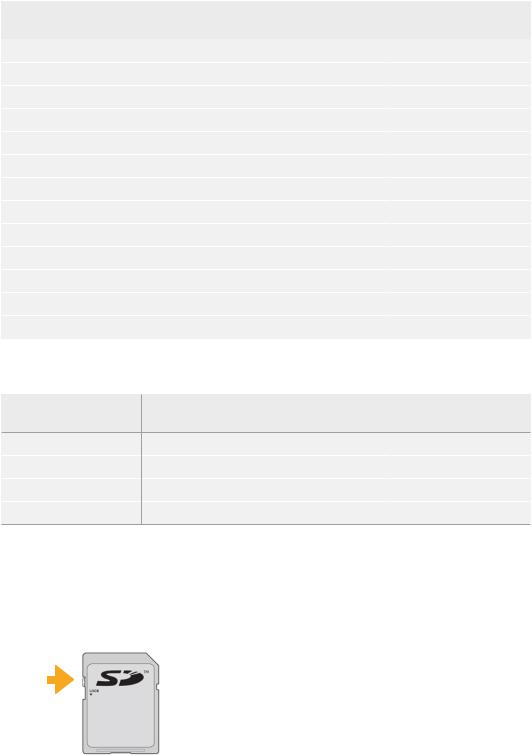
The following SD cards are recommended for recording 4K DCI Blackmagic RAW 12:1 up to 30 fps on Blackmagic Pocket Cinema Camera 4K.
Brand |
Card Name |
Storage |
|
|
|
Angelbird |
AV PRO SD V90 |
64GB |
Delkin Devices |
Power UHS-II SDXC |
64GB |
Delkin Devices |
Power UHS-II SDXC |
128GB |
Lexar |
Professional 2000x UHS-II 300MB/s SDXC |
64GB |
ProGrade Digital |
V90 UHS-II 250MB/s SDXC |
256GB |
SanDisk |
Extreme Pro UHS-I 95MB/s SDXC |
512GB |
Sony |
SF-G64 300MB/s UHS-II SDXC |
64GB |
Sony |
Tough SF-G64T |
64GB |
Sony |
Tough SF-G128T |
128GB |
Toshiba |
Exceria Pro UHS-II N502 SDHC |
32GB |
Toshiba |
Exceria Pro UHS-II 270MB/s SDXC |
64GB |
Wise |
SDXC UHS-II |
64GB |
Wise |
SDXC UHS-II |
128GB |
|
|
|
The following SD cards are recommended for recording 4K DCI ProRes HQ up to 60 fps on Blackmagic Pocket Cinema Camera 4K.
Brand
Sony
Sony
Wise
Wise
Card Name |
Storage |
Tough SF-G64T |
64GB |
Tough SF-G128T |
128GB |
SDXC UHS-II |
64GB |
SDXC UHS-II |
128GB |
|
|
Locking and Unlocking SD Cards
SD cards can be write protected, or ‘locked’, to prevent data from being overwritten. When inserting an SD card, make sure the card is not write protected. To disable write protection, slide the plastic switch on the left side of the card to the position closest to the connectors. You can always set the card to the locked again after recording.
Move the lock tab up or down to lock or unlock an SD card
Your Blackmagic Pocket Cinema Camera lets you know if you’ve inserted a locked SD card by displaying the word ‘locked’ instead of the card’s duration on the LCD touchscreen, and will display a padlock icon in the storage menu next to the card name. If the card is locked, you won’t be able to record video, capture stills, or export LUTs and presets until it is unlocked.
Storage Media |
10 |
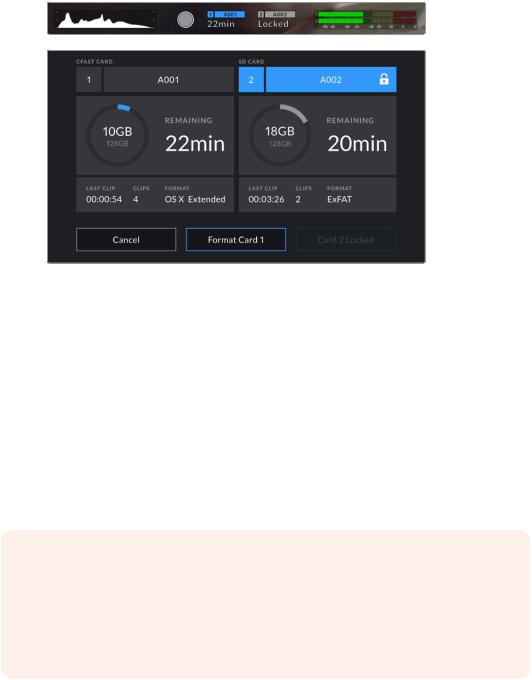
USB-C flash disks
Your Blackmagic Pocket Cinema Camera features a high speed USB-C expansion port, which allows you to record video directly to USB-C flash disks. These fast, high capacity drives allow you to record video for long periods, which can be important when filming events with long durations.
Once you have finished recording you can connect the same drive directly to your computer for editing and post production, without having to copy media across.
To connect to a USB-C flash disk:
1Connect one end of a USB type-C cable to your USB-C flash disk.
2Open the rubber protector on the left side of the camera and connect the other end of the cable to the USB-C port.
NOTE When a USB-C flash disk is connected to your camera, it occupies the same place as the SD card in your camera’s operating system. This means that
when you have a compatible USB-C flash disk connected, your camera’s SD card slot is unavailable.
To use the SD card slot instead of the USB-C flash disk, disconnect the USB-C flash disk from your camera.
Choosing a fast USB-C flash disk
USB-C flash disks are designed to offer fast, affordable storage for a wide range of devices and are readily available from a variety of consumer electronics outlets. It’s important to note that film making is only one part of the USB-C flash disk market, so choosing the best drive is vital to making sure you have enough speed to record 6K and 4K footage.
Many USB-C flash disks are designed for home computing and aren’t fast enough to record 6K and 4K video. We highly recommend using only the USB-C flash disks from our recommended list. These USB-C flash disks have been tested with Blackmagic Pocket Cinema Camera to support continuous filming at the specified resolutions.
For the most up to date list of recommended USB-C flash disks please go to www.blackmagicdesign.com/support.
Storage Media |
11 |

The following USB-C drives are recommended for recording 4K DCI ProRes HQ up to 60 fps.
Brand |
Card Name |
Storage |
|
|
|
Angelbird |
SSD2GO PKT |
512GB |
Angelbird |
SSD2GO PKT |
2TB |
Glyph |
Atom |
500GB |
Samsung |
Portable SSD T5 |
500GB |
Samsung |
Portable SSD T5 |
1TB |
SanDisk |
Extreme Portable SSD |
1TB |
Seagate |
Fast SSD |
250GB |
Wise |
Portable SSD |
256GB |
Wise |
Portable SSD |
512GB |
Wise |
Portable SSD |
1TB |
|
|
|
The following USB-C drives are recommended for recording 4K DCI Blackmagic RAW 3:1 up to 60 fps.
Brand |
Card Name |
Storage |
|
|
|
Angelbird |
SSD2GO PKT |
512GB |
Angelbird |
SSD2GO PKT |
2TB |
G-Technology |
G-DRIVE Mobile SSD |
1TB |
Wise |
Portable SSD |
512GB |
|
|
|
Important Notes About USB-C flash disk Speed
Some models of USB-C flash disk can’t save video data at the speed the manufacturer claims. This is due to the disk using hidden data compression to attain higher write speeds. This data compression can only save data at the manufacturer’s claimed speed when storing data such as blank data or simple files. Video data includes video noise and pixels which are more random so compression will not help, therefore revealing the true speed of the disk.
Some USB-C flash disks can have as much as 50% less write speed than the manufacturer’s claimed speed. So even though the disk specifications claim a USB-C flash disk has speeds fast enough to handle video, in reality the disk isn’t fast enough for real time video capture.
Use Blackmagic Disk Speed Test to accurately measure whether your USB-C flash disk will be able to handle high data rate video capture and playback. Blackmagic Disk Speed Test uses data to simulate the storage of video so you get results similar to what you’ll see when capturing video to a disk. During Blackmagic testing, we have found newer, larger models of USB-C flash disk and larger capacity USB-C flash disks are generally faster.
Blackmagic Disk Speed Test is available from the Mac app store. Windows and macOS versions are also included in Blackmagic Desktop Video, which you can download from the ‘capture and playback’ section of the Blackmagic Design support center at www.blackmagicdesign.com/support.
Storage Media |
12 |
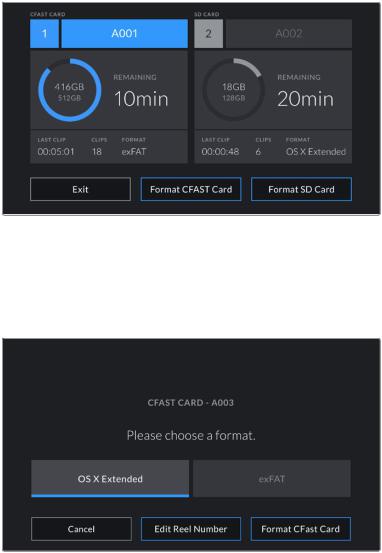
Preparing Media for Recording
You can format your CFast cards, SD cards or USB-C flash disks using the ‘format card’ feature on your camera’s storage and formatting menu, or via a Mac or Windows computer. For best performance, we recommend formatting storage media using your camera.
HFS+ is also known as OS X Extended and is the recommended format as it supports ‘journaling’. Data on journaled media is more likely to be recovered in the rare event that your storage media becomes corrupted. HFS+ is natively supported by macOS. exFAT is supported natively by macOS and Windows without needing any additional software, but does not support journaling.
Preparing Media on Blackmagic Pocket Cinema Camera
1Tap either storage indicator at the bottom of the LCD touchscreen to enter the storage manager.
2Tap ‘Format CFast card’ or ‘Format SD card’. If you have a USB-C flash disk connected to your camera, ‘Format drive’ will be displayed instead of ‘Format SD card’.
‘Format SD card’ is replaced with ‘Format external drive’ in your storage and formatting screen when you have a USB-C flash disk connected to your camera
3Tap ‘edit reel number’ if you would like to manually change the reel number. Use the keypad to enter a new reel number and press ‘update’ to confirm your selection.
4Choose OS X Extended or exFAT format and tap the format button.
Tap ‘edit reel number’ to manually edit the reel number
Storage Media |
13 |
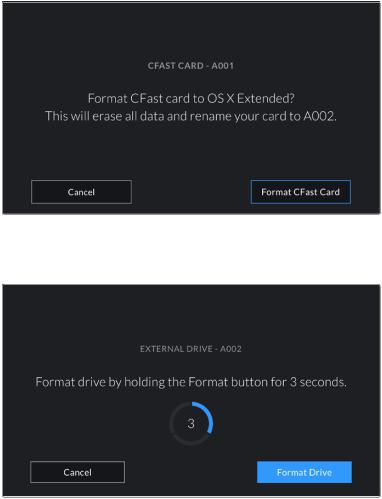
5A confirmation screen will allow you to confirm the card to be formatted, the selected format and the reel number. Confirm your selection by tapping the format button. Tap ‘cancel’ to cancel the format.
Check that you have selected the correct card before formatting
6 Hold down the format button for three seconds to format your media.
7The camera notifies you when the format is complete and your drive is ready for use, or if formatting has failed.
8Tap ‘ok’ to return to the storage manager.
9Tap ‘exit’ to leave the storage manager.
When formatting CFast cards, SD cards or USB-C flash disks using your camera, the camera ID that is generated from the slate and reel number are used to name the media. Your camera automatically adjusts the reel numbers incrementally each time you format. If you need to manually enter a specific reel number, tap the ‘edit reel number’ and enter the number you want to format the card as.
Tap on ‘reset project data’ in the ‘project’ tab of the slate if you’re starting a new project and want the numbering to reset back to 1.
Storage Media |
14 |
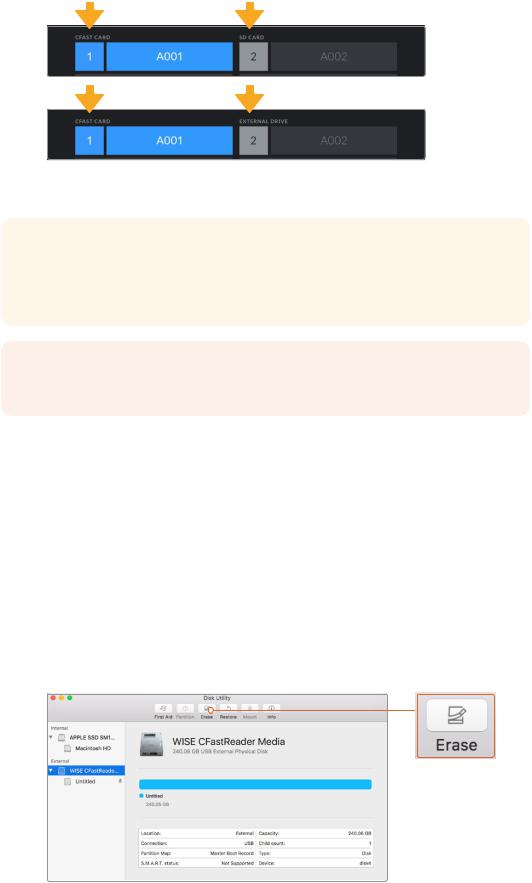
The storage manager on your camera indicates whether you are currently managing CFast, SD or USB-C flash disk media
TIP If the SD card is write protected, your camera will display the word ‘locked’ instead of the card’s duration on the LCD touchscreen, and will display a padlock icon in the storage menu. Unlock the card to format and record. For more information, refer to the ‘SD cards’ section of this manual.
NOTE If you have a USB-C flash disk connected, ‘external drive’ appears over storage slot 2.
Preparing Media on a Mac
Use the Disk Utility application included with macOS to format your CFast card, SD card, or USB-C flash disk in the HFS+ or exFAT formats. Remember to backup anything important from your media first as all data will be lost when it is formatted.
1Connect the storage media to your computer and dismiss any message offering to use your media for Time Machine backups.
2Go to applications/utilities and launch Disk Utility.
3Click on the disk icon for your camera’s storage media and then click the ‘erase’ tab.
4Set the ‘format’ to ‘Mac OS extended (journaled)’ or ‘exFAT’.
5Type a ‘name’ for the new volume and then click ‘erase’. Your camera’s storage media will quickly be formatted and made ready for use.
Use Disk Utility on macOS to erase your camera’s storage media in the Mac OS extended (journaled) or exFAT format
Storage Media |
15 |
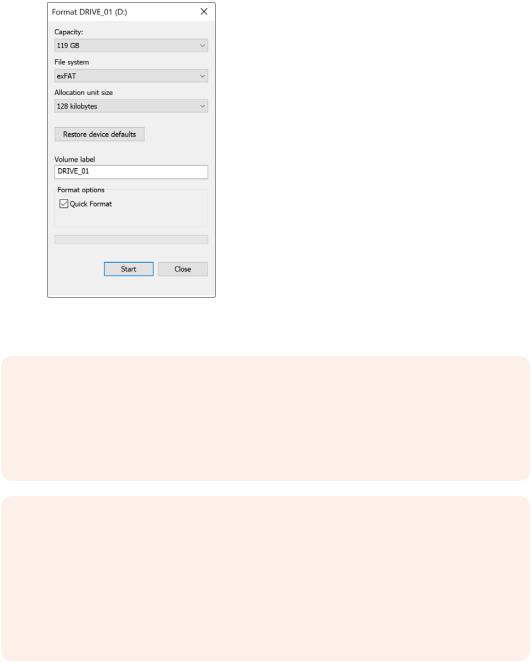
Preparing Media on Windows
The ‘format’ dialog box can format your camera’s storage media in the exFAT format on a Windows PC. Remember to backup anything important from your media first as all data will be lost when it is formatted.
1Connect your camera’s storage media to your computer using an external reader, USB-C cable or adapter.
2Open the ‘start’ menu or ‘start’ screen and choose ‘computer’. Right click on your camera’s storage media.
3From the contextual menu, choose ‘format’.
4Set the file system to ‘exFAT’ and the allocation unit size to 128 kilobytes.
5Type a volume label, select ‘quick format’ and click ‘start’.
6Your storage media will quickly be formatted and made ready for use.
Use the ‘format’ dialog box feature in Windows to format your camera’s storage media in the exFAT format
NOTE If your recordings are dropping frames, check that your card or drive is on our list of recommended media for the codec and frame size you are using. For lower data rates try lowering your frame rate, resolution, or try a compressed codec such as ProRes. Check the Blackmagic Design website for the latest information at www.blackmagicdesign.com
NOTE Partitioned media can be used with your Blackmagic Pocket Cinema Camera, though your camera will only recognize the first partition of your media for recording and playback.
It’s worth noting that if you use the storage and formatting menu to format your media, the entire drive including all partitions will be erased, not just the first partition that has been used for recording and playback. For this reason we strongly recommend using media with one partition only.
Storage Media |
16 |
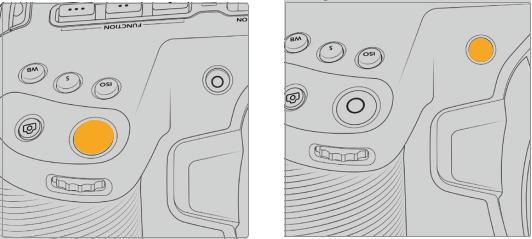
Recording
Recording Clips
Blackmagic Pocket Cinema Camera features two record buttons. The primary record button is located on the top of the handgrip for triggering with your index finger when holding the handgrip of the camera with your right hand.
The second record button is located on the front of your camera to allow you to begin recording while holding the camera with one hand in situations where you want to record yourself. The button is located in an easy to reach position, ideal if you are recording yourself for video blogs.
Press one of the ‘record’ buttons on your camera to begin recording immediately. Press ‘record’ again to stop recording.
Before you start recording, tap and hold the name of the media at the bottom of the touchscreen to select the memory card or USB-C flash disk you want to use. The bar over the media type you have selected turns blue to indicate the camera is set to record to this media. To record to a different card or drive, tap and hold the name of the media. While recording, the bar is red.
The ‘record’ button located on the top panel of your camera
The ‘record’ button located on the front of your camera
Choosing the Recording Format
Blackmagic Pocket Cinema Camera records using Apple ProRes codecs including ProRes 422 HQ, ProRes 422, ProRes 422 LT and ProRes 422 Proxy. ProRes codecs let you fit more video on your SD card, CFast card or USB-C flash disk. ProRes 422 HQ provides the highest quality video with the lowest compression. Alternatively, ProRes 422 Proxy gives you far more recording time with greater compression. Your camera can also record with the Blackmagic RAW format. You may decide to experiment to see which format best suits your workflow.
It’s important to note that Blackmagic Pocket Cinema Camera 6K uses Blackmagic RAW for full sensor and windowed sensor formats, and ProRes for scaled formats. For more information on windowed and scaled formats, see the ‘Blackmagic Pocket Cinema Camera 6K Maximum Sensor Frame Rates’ section.
Recording 17
Blackmagic RAW
Blackmagic Pocket Cinema Camera supports the Blackmagic RAW file format. This format offers superior image quality, wide dynamic range and a broad selection of compression ratios. Blackmagic RAW features all the user benefits of RAW recording, but the files are very fast because most of the processing is performed in the camera where it can be hardware accelerated by the camera itself. This means that Blackmagic RAW plays back at normal speed on most computers, without needing to cache it first or lower the resolution.
Blackmagic RAW also includes powerful metadata support so the software reading the files knows your camera settings. If you like shooting in video gamma because you need to turn around edits quickly and you don’t have time for color correction, then this metadata feature means you can select video gamma, shoot in video gamma, and the file will display with video gamma applied when you open it in software. However underneath, the file is actually film gamma and the metadata in the file is what’s telling the software to apply the video gamma.
So what all this means is if you want to color grade your images at some point, then you have all that film dynamic range preserved in the file. You don’t have your images hard clipped in the whites or the blacks, so you retain detail and you can color grade to make all your images look cinematic. However, if you don’t have time for color grading, that’s fine because your images will have the video gamma applied and look like normal video camera images. You are not locked in on the shoot and you can change your mind later during post production.
Blackmagic RAW files are extremely fast and the codec is optimized for your computer’s CPU and GPU. This means it has fast smooth playback and eliminates the need for hardware decoder boards, which is important for laptop use. Software that reads Blackmagic RAW also gets the advantage of processing via Apple Metal, Nvidia CUDA and OpenCL.
This means that Blackmagic RAW plays back at normal speed like a video file on most computers, without needing to cache it first or lower the resolution.
It’s also worth mentioning that lens information is recorded in the metadata on a frame by frame basis. For example, when using compatible lenses, any zoom or focus changes performed over the length of a clip will be saved, frame by frame, to the metadata in the Blackmagic RAW file.
Recording to Blackmagic RAW
Blackmagic RAW works in 2 different ways. You have a choice to use either the constant bitrate codec, or the constant quality codec.
The constant bitrate codec works in a similar way to most codecs. It tries to keep the data rate at a consistent level and won’t let the data rate go too high. This means even if you are shooting a complex image that might need a bit more data to store the image, a constant bitrate codec will just compress the image harder to make sure the images fit within the space allocated.
This can be fine for video codecs, however when shooting Blackmagic RAW you really want to ensure the quality is predictable. What would happen if the images you were shooting needed more data, but the codec just compresses harder to make a specified data rate? It’s possible you could lose quality, but not be sure it’s happening until you return from a shoot.
To solve this problem, Blackmagic RAW also has an alternative codec choice called constant quality. This codec is technically called a variable bitrate codec, but what it’s really doing is allowing the size of the file to grow if your images need extra data. There is no upper limit on the file size if you need to encode an image but maintain quality.
So Blackmagic RAW set to the constant quality setting will just let the file grow as big as it needs to be to encode your images. It also means the files could be larger or smaller depending on what you are shooting. I guess if you leave your lens cap on the lens, you won’t waste space on your media!
Recording 18
It is also worth noting that the quality settings for Blackmagic RAW are not obscure names,
but are more meaningful as they are derived from what’s happening technically. So for example when you have selected the constant bitrate codec, you will see quality settings of 3:1, 5:1,
8:1 and 12:1. These are the ratios of the uncompressed RAW file size vs the file sizes you should expect when shooting in Blackmagic RAW. 3:1 is better quality as the file is larger, while 12:1 is the smallest file size with the lowest quality. Many users of Blackmagic RAW find that 12:1 has been perfectly ok and they have not seen any quality limitations. However it’s best to experiment and try various settings for yourself.
When using Blackmagic RAW in constant quality you will see the settings are Q0 and Q5. These are the compression parameters passed to the codec and they are setting how much compression is applied in a more technical way. This setting is different because the codec operates differently between constant bitrate vs constant quality. In this constant quality setting, you really cannot tell what the file size ratio will become as it varies a lot based on what you
are shooting. So in this case the setting is different and the file will become the size needed to store your media.
Constant Bitrate Settings
The names for 3:1, 5:1, 8:1 and 12:1 represent the compression ratio. For example,
12:1 compression produces a file size roughly 12 times smaller than uncompressed RAW.
Constant Quality Settings
Q0 and Q5 refer to different levels of quantization. Q5 has a greater level of quantization but offers a greatly improved data rate. As mentioned above, the constant quality setting can result in files that grow and shrink quite a lot, depending on what you are shooting. This also means it’s possible to shoot something and see the file size increase to beyond what your media card can keep up with. It could result in dropped frames. However the benefit is that you can instantly see if this happens on a shoot and then investigate your settings vs quality.
Blackmagic RAW Player
The Blackmagic RAW player included in your Blackmagic camera’s software installer is a streamlined application for reviewing clips. Simply double click on a Blackmagic RAW file to open it, and you can quickly play and scroll through the file with its full resolution and bit depth.
When decoding frames, the CPU acceleration in the SDK library supports all main architectures, and also supports GPU acceleration via Apple Metal, Nvidia CUDA and OpenCL. It also works with the Blackmagic eGPU for extra performance. Blackmagic RAW player is currently available on macOS and will be available for Windows in an upcoming release.
Sidecar Files
Blackmagic RAW sidecar files let you override metadata in a file without overwriting embedded metadata in the original file. This metadata includes the Blackmagic RAW settings as well as information on iris, focus, focal length, while balance, tint, color space, project name, take number and more. Metadata is encoded frame by frame over the duration of the clip, which is important for lens data if the lens is adjusted during a shot. You can add or edit metadata in sidecar files with DaVinci Resolve or even a text editor because it’s a human readable format.
Sidecar files can be used to automatically add new Blackmagic RAW settings to a playback simply by moving the sidecar file into the same folder as the corresponding Blackmagic RAW file. If you move the sidecar file out of the folder and reopen the Blackmagic RAW file,
the changed settings are not applied and you see the file as it was originally shot. Any software that uses the Blackmagic RAW SDK can access these settings. Changes made are saved in the sidecar file and can then be seen by Blackmagic RAW Player or any other software capable of reading Blackmagic RAW files.
Recording 19
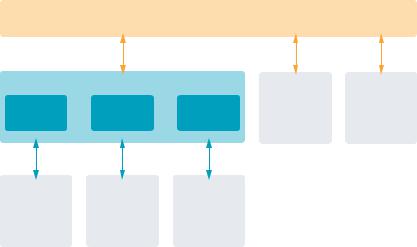
When shooting video gamma, the file stays in film gamma, and the metadata tells the Blackmagic RAW processing to display using video gamma. Video gamma is great when you don’t want to grade the image and want to deliver content quickly, however if you want to pull up the black parts of the image, or pull down the white areas, all the detail is retained. You never clip the video and all the detail is still there if you want to access it at any time.
Blackmagic RAW in DaVinci Resolve
Settings can be adjusted for each Blackmagic RAW file, and then saved as a new sidecar file from the ‘Camera RAW’ tab in DaVinci Resolve for creative effect or optimized viewing. This also means you can copy your media for another DaVinci Resolve artist and they will have access to your modified gamma settings automatically on import. In addition to the other metadata your camera files contain, DaVinci Resolve can read your selected dynamic range, so your clips will automatically display in DaVinci Resolve with ‘film’, ‘extended video’ or ‘video’ dynamic range.
You can then customize these settings by adjusting the saturation, contrast and midpoint,
as well as the highlight and shadow rolloff. Any adjustments can then be saved as a sidecar file, so the changes can be seen by anyone else working with the files in post. You can always return to the original camera metadata at any time.
You can also export a single Blackmagic RAW frame from the ‘Camera RAW’ tab in DaVinci Resolve, which contains all adjustments, metadata, full resolution and color information so it is easy to share a single frame grab or reference file with others.
For more information on how to use Blackmagic RAW in DaVinci Resolve, see the ‘Using DaVinci Resolve’ chapter in this manual.
Blackmagic RAW Software Development Kit
The Blackmagic RAW Software Development Kit is an API developed by Blackmagic Design. You can use the Blackmagic RAW SDK to write your own applications to use the Blackmagic RAW format. This SDK library can be used by any developer to add support for reading, editing, and saving Blackmagic RAW files. The Blackmagic RAW SDK includes all the generation 4 color science so you can achieve organic cinematic images across any app that supports it. The Blackmagic RAW SDK supports Mac, Windows and Linux, and is available as a free download from the developer page of the Blackmagic website at www.blackmagicdesign.com/developer
The following diagram illustrates the components of the Blackmagic RAW API:
Blackmagic RAW API
|
Decoder |
|
|
|
SSE |
AVX |
AVX2 |
.Braw |
.Sidecar |
Reader |
Reader |
METAL CUDA OPENCL
Recording 20

Blackmagic Pocket Cinema Camera 6K Maximum Sensor Frame Rates
This table contains available codecs, resolutions and their maximum sensor frame rates for Blackmagic Pocket Cinema Camera 6K.
|
Resolution |
Codec |
Sensor Scan |
Max Frame Rate |
|
|
|
|
|
|
|
6K |
6144 x 3456 |
Blackmagic RAW |
Full |
50 |
|
|
|
|
|
|
|
6K 2.4:1 |
6144 x 2560 |
Blackmagic RAW |
Window |
60 |
|
|
|
|
|
|
|
5.7K 17:9 |
5744 x 3024 |
Blackmagic RAW |
Window |
60 |
|
|
|
|
|
|
|
|
4096 x 2160 |
ProRes 422 HQ |
Scaled from 5.7K |
60 |
|
4K DCI |
4096 x 2160 |
ProRes 422 |
Scaled from 5.7K |
60 |
|
4096 x 2160 |
ProRes 422 LT |
Scaled from 5.7K |
60 |
||
|
|||||
|
4096 x 2160 |
ProRes 422 Proxy |
Scaled from 5.7K |
60 |
|
|
|
|
|
|
|
|
3840 x 2160 |
ProRes 422 HQ |
Scaled from full |
50 |
|
|
3840 x 2160 |
ProRes 422 |
Scaled from full |
50 |
|
|
3840 x 2160 |
ProRes 422 LT |
Scaled from full |
50 |
|
Ultra HD |
3840 x 2160 |
ProRes 422 Proxy |
Scaled from full |
50 |
|
3840 x 2160 |
ProRes 422 HQ |
Scaled from 5.7K |
60 |
||
|
|||||
|
3840 x 2160 |
ProRes 422 |
Scaled from 5.7K |
60 |
|
|
3840 x 2160 |
ProRes 422 LT |
Scaled from 5.7K |
60 |
|
|
3840 x 2160 |
ProRes 422 Proxy |
Scaled from 5.7K |
60 |
|
|
|
|
|
|
|
3.7K Anamorphic |
3728 x 3104 |
Blackmagic RAW |
Window |
60 |
|
|
|
|
|
|
|
2.8K 17:9 |
2868 x 1512 |
Blackmagic RAW |
Window |
120 |
|
|
|
|
|
|
|
|
1920 x 1080 |
ProRes 422 HQ |
Scaled from full |
50 |
|
|
1920 x 1080 |
ProRes 422 |
Scaled from full |
50 |
|
|
1920 x 1080 |
ProRes 422 LT |
Scaled from full |
50 |
|
|
1920 x 1080 |
ProRes 422 Proxy |
Scaled from full |
50 |
|
|
1920 x 1080 |
ProRes 422 HQ |
Scaled from 5.7K |
60 |
|
HD |
1920 x 1080 |
ProRes 422 |
Scaled from 5.7K |
60 |
|
1920 x 1080 |
ProRes 422 LT |
Scaled from 5.7K |
60 |
||
|
|||||
|
1920 x 1080 |
ProRes 422 Proxy |
Scaled from 5.7K |
60 |
|
|
1920 x 1080 |
ProRes 422 HQ |
Scaled from 2.7K |
120 |
|
|
1920 x 1080 |
ProRes 422 |
Scaled from 2.7K |
120 |
|
|
1920 x 1080 |
ProRes 422 LT |
Scaled from 2.7K |
120 |
|
|
1920 x 1080 |
ProRes 422 Proxy |
Scaled from 2.7K |
120 |
|
|
|
|
|
|
Recording 21

Blackmagic Pocket Cinema Camera 4K Maximum Sensor Frame Rates
This table contains available codecs, resolutions and their maximum sensor frame rates for Blackmagic Pocket Cinema Camera 4K.
|
Resolution |
Codec |
Sensor Scan |
Max Frame Rate |
|
|
|
|
|
|
4096 x 2160 |
Blackmagic RAW |
Full |
60 |
|
4096 x 2160 |
ProRes 422 HQ |
Full |
60 |
4K DCI |
4096 x 2160 |
ProRes 422 |
Full |
60 |
|
4096 x 2160 |
ProRes 422 LT |
Full |
60 |
|
4096 x 2160 |
ProRes 422 Proxy |
Full |
60 |
|
|
|
|
|
|
3840 x 2160 |
Blackmagic RAW |
Window |
60 |
|
3840 x 2160 |
ProRes 422 HQ |
Window |
60 |
Ultra HD |
3840 x 2160 |
ProRes 422 |
Window |
60 |
|
3840 x 2160 |
ProRes 422 LT |
Window |
60 |
|
3840 x 2160 |
ProRes 422 Proxy |
Window |
60 |
|
|
|
|
|
|
1920 x 1080 |
ProRes 422 HQ |
Scaled from full |
60 |
|
1920 x 1080 |
ProRes 422 |
Scaled from full |
60 |
|
1920 x 1080 |
ProRes 422 LT |
Scaled from full |
60 |
|
1920 x 1080 |
ProRes 422 Proxy |
Scaled from full |
60 |
HD |
1920 x 1080 |
Blackmagic RAW |
Window |
120 |
|
1920 x 1080 |
ProRes 422 HQ |
Window |
120 |
|
1920 x 1080 |
ProRes 422 |
Window |
120 |
|
1920 x 1080 |
ProRes 422 LT |
Window |
120 |
|
1920 x 1080 |
ProRes 422 Proxy |
Window |
120 |
|
|
|
|
|
Record Duration
These tables show approximate record duration in minutes and seconds based on format, project frame rate and media size. It’s important to note that available resolutions and codecs differ for Pocket Cinema Camera 6K and Pocket Cinema Camera 4K.
The maximum recording time for your storage media can vary depending on the data capacity your CFast card, SD card or USB-C flash disk, and the recording format and frame rate you choose. For example, the storage rate for Apple ProRes 422 HQ at 3840 x 2160 is approximately 880 Mbps. At 24 frames per second, you can record approximately 47 minutes of video on a 256GB CFast 2.0 card. At the same settings you can record approximately
23 minutes of video on a 128GB CFast card, which is approximately half the record duration of a 256GB CFast card.
It should be noted that recording duration of media can vary slightly between different manufacturers. It can also vary depending on whether the storage media is formatted as exFAT or Mac OS X Extended.
Simple scenes containing less detail tend to require less data than more dense compositions. The values in these tables assume shots with a high complexity, which means you may get slightly longer record times depending on the nature of your shoot.
Recording 22

6K
CFast |
Frame |
Blackmagic |
Blackmagic |
Blackmagic |
Blackmagic |
Card |
Rate |
RAW 3:1 |
RAW 5:1 |
RAW 8:1 |
RAW 12:1 |
|
|
|
|
|
|
|
|
Duration |
Duration |
Duration |
Duration |
|
|
|
|
|
|
|
23.98 |
17 mins |
28 mins |
45 mins |
67 mins |
|
24 |
17 mins |
28 mins |
45 mins |
67 mins |
256GB |
25 |
16 mins |
27 mins |
43 mins |
64 mins |
|
30 |
13 mins |
22 mins |
36 mins |
54 mins |
|
50 |
8 mins |
13 mins |
21 mins |
32 mins |
|
|
|
|
|
|
6K 2.4:1
CFast |
Frame |
Blackmagic |
Blackmagic |
Blackmagic |
Blackmagic |
|
Card |
Rate |
RAW 3:1 |
RAW 5:1 |
RAW 8:1 |
RAW 12:1 |
|
|
|
|
|
|
|
|
|
|
Duration |
Duration |
Duration |
Duration |
|
|
|
|
|
|
|
|
|
23.98 |
23 mins |
38 mins |
60 mins |
91 mins |
|
|
24 |
22 mins |
38 mins |
60 mins |
91 mins |
|
256GB |
25 |
21 mins |
36 mins |
58 mins |
87 mins |
|
30 |
18 mins |
30 mins |
48 mins |
72 mins |
||
|
||||||
|
50 |
11 mins |
18 mins |
29 mins |
43 mins |
|
|
60 |
9 mins |
15 mins |
24 mins |
36 mins |
|
|
|
|
|
|
|
5.7K 17:9
CFast |
Frame |
Blackmagic |
Blackmagic |
Blackmagic |
Blackmagic |
|
Card |
Rate |
RAW 3:1 |
RAW 5:1 |
RAW 8:1 |
RAW 12:1 |
|
|
|
|
|
|
|
|
|
|
Duration |
Duration |
Duration |
Duration |
|
|
|
|
|
|
|
|
|
23.98 |
20 mins |
34 mins |
55 mins |
82 mins |
|
|
24 |
20 mins |
34 mins |
55 mins |
82 mins |
|
256GB |
25 |
19 mins |
33 mins |
52 mins |
79 mins |
|
30 |
16 mins |
27 mins |
44 mins |
66 mins |
||
|
||||||
|
50 |
10 mins |
16 mins |
26 mins |
39 mins |
|
|
60 |
8 mins |
13 mins |
22 mins |
33 mins |
|
|
|
|
|
|
|
Recording 23

4K DCI
CFast |
Frame |
Blackmagic |
Blackmagic |
Blackmagic |
Blackmagic |
ProRes |
ProRes |
ProRes |
ProRes |
|
Card |
Rate |
RAW 3:1 |
RAW 5:1 |
RAW 8:1 |
RAW 12:1 |
422 HQ |
422 |
422 LT |
422 Proxy |
|
|
|
|
|
|
|
|
|
|
|
|
|
|
Duration |
Duration |
Duration |
Duration |
Duration |
Duration |
Duration |
Duration |
|
|
|
|
|
|
|
|
|
|
|
|
|
23.98 |
39 mins |
65 mins |
104 mins |
155 mins |
44 mins |
66 mins |
95 mins |
216 mins |
|
|
24 |
39 mins |
65 mins |
103 mins |
155 mins |
44 mins |
66 mins |
95 mins |
216 mins |
|
256GB |
25 |
37 mins |
62 mins |
99 mins |
149 mins |
42 mins |
64 mins |
91 mins |
207 mins |
|
30 |
31 mins |
52 mins |
83 mins |
124 mins |
35 mins |
53 mins |
76 mins |
173 mins |
||
|
||||||||||
|
50 |
18 mins |
31 mins |
49 mins |
74 mins |
21 mins |
32 mins |
45 mins |
104 mins |
|
|
60 |
15 mins |
26 mins |
41 mins |
62 mins |
17 mins |
26 mins |
38 mins |
87 mins |
|
|
|
|
|
|
|
|
|
|
|
ULTRA HD
CFast |
Frame |
Blackmagic |
Blackmagic |
Blackmagic |
Blackmagic |
ProRes |
ProRes |
ProRes |
ProRes |
|
Card |
Rate |
RAW 3:1 |
RAW 5:1 |
RAW 8:1 |
RAW 12:1 |
422 HQ |
422 |
422 LT |
422 Proxy |
|
|
|
|
|
|
|
|
|
|
|
|
|
|
Duration |
Duration |
Duration |
Duration |
Duration |
Duration |
Duration |
Duration |
|
|
|
|
|
|
|
|
|
|
|
|
|
23.98 |
41 mins |
68 mins |
110 mins |
164 mins |
47 mins |
71 mins |
101 mins |
230 mins |
|
|
24 |
41 mins |
68 mins |
109 mins |
164 mins |
47 mins |
71 mins |
101 mins |
230 mins |
|
256GB |
25 |
39 mins |
66 mins |
105 mins |
157 mins |
45 mins |
68 mins |
97 mins |
221 mins |
|
30 |
33 mins |
55 mins |
88 mins |
131 mins |
38 mins |
57 mins |
81 mins |
184 mins |
||
|
||||||||||
|
50 |
19 mins |
33 mins |
52 mins |
79 mins |
22 mins |
34 mins |
48 mins |
111 mins |
|
|
60 |
16 mins |
27 mins |
44 mins |
66 mins |
18 mins |
28 mins |
40 mins |
92 mins |
|
|
|
|
|
|
|
|
|
|
|
3.7K Anamorphic
CFast |
Frame |
Blackmagic |
Blackmagic |
Blackmagic |
Blackmagic |
|
Card |
Rate |
RAW 3:1 |
RAW 5:1 |
RAW 8:1 |
RAW 12:1 |
|
|
|
|
|
|
|
|
|
|
Duration |
Duration |
Duration |
Duration |
|
|
|
|
|
|
|
|
|
23.98 |
31 mins |
51 mins |
82 mins |
123 mins |
|
|
24 |
31 mins |
51 mins |
82 mins |
123 mins |
|
256GB |
25 |
29 mins |
49 mins |
79 mins |
118 mins |
|
30 |
24 mins |
41 mins |
65 mins |
98 mins |
||
|
||||||
|
50 |
15 mins |
24 mins |
39 mins |
59 mins |
|
|
60 |
12 mins |
20 mins |
33 mins |
49 mins |
|
|
|
|
|
|
|
Recording 24

2.8K 17:9
CFast |
Frame |
Blackmagic |
Blackmagic |
Blackmagic |
Blackmagic |
Card |
Rate |
RAW 3:1 |
RAW 5:1 |
RAW 8:1 |
RAW 12:1 |
|
|
|
|
|
|
|
|
Duration |
Duration |
Duration |
Duration |
|
|
|
|
|
|
|
23.98 |
81 mins |
136 mins |
216 mins |
321 mins |
|
24 |
81 mins |
135 mins |
215 mins |
320 mins |
|
25 |
78 mins |
130 mins |
207 mins |
308 mins |
256GB |
30 |
65 mins |
108 mins |
173 mins |
258 mins |
|
50 |
39 mins |
65 mins |
104 mins |
156 mins |
|
60 |
32 mins |
54 mins |
87 mins |
130 mins |
|
120 |
16 mins |
27 mins |
43 mins |
65 mins |
|
|
|
|
|
|
HD
CFast |
Frame |
Blackmagic |
Blackmagic |
Blackmagic |
Blackmagic |
ProRes |
ProRes |
ProRes |
ProRes |
Card |
Rate |
RAW 3:1 |
RAW 5:1 |
RAW 8:1 |
RAW 12:1 |
422 HQ |
422 |
422 LT |
422 Proxy |
|
|
|
|
|
|
|
|
|
|
|
|
Duration |
Duration |
Duration |
Duration |
Duration |
Duration |
Duration |
Duration |
|
|
|
|
|
|
|
|
|
|
|
23.98 |
159 mins |
264 mins |
418 mins |
619 mins |
189 mins |
283 mins |
403 mins |
877 mins |
|
24 |
159 mins |
264 mins |
418 mins |
618 mins |
189 mins |
283 mins |
403 mins |
877 mins |
|
25 |
153 mins |
253 mins |
402 mins |
595 mins |
182 mins |
271 mins |
387 mins |
843 mins |
256GB |
30 |
127 mins |
212 mins |
336 mins |
499 mins |
152 mins |
227 mins |
324 mins |
710 mins |
|
50 |
76 mins |
127 mins |
203 mins |
303 mins |
91 mins |
137 mins |
196 mins |
434 mins |
|
60 |
64 mins |
106 mins |
170 mins |
254 mins |
76 mins |
114 mins |
163 mins |
363 mins |
|
120 |
32 mins |
54 mins |
87 mins |
130 mins |
38 mins |
57 mins |
82 mins |
185 mins |
|
|
|
|
|
|
|
|
|
|
NOTE It’s important to note that 6K, 6K 2.4:1, 5.7K 17:9, 3.7K Anamorphic and 2.8K 17:9 formats are available on Blackmagic Pocket Cinema Camera 6K only. Blackmagic Pocket Cinema Camera 6K uses ProRes for 4K DCI, Ultra HD and HD formats.
Constant quality settings for Q0 and Q5 will display varying record time remaining durations. The estimated duration for Q0 is similar to constant bitrate 3:1, and Q5 will display a similar duration to 12:1, however, as the estimated duration updates every 10 seconds while recording, the best way to gauge how much recording time you have is to record for 20 seconds and monitor the duration in the media area of the touchscreen display.
Choosing Frame Rates
Your camera is able to shoot video using many different frame rates and you may be wondering which is the best one to use.
Generally, when selecting a sensor frame rate, there are some common items to consider. For many years, there have been presentation standards for film and television. These have set frame rates that differ between countries, but all share the same purpose; to display an efficient number of frames every second that portrays pleasing and convincing motion.
Recording 25

Cinema, for example, uses a standard 24 frames per second and while there have been recent experiments with faster frame rates, 24 frames per second remains widely accepted for international audiences.
Television frame rates have generally conformed to technical broadcast standards for each country. For example, if you were making television content you would typically record using 29.97 frames per second for North American distribution, and 25 frames per second for Europe.
However, as technology has improved, today we have more choices and broadcast standards are changing. It is now common for sporting events to be recorded and broadcasted at higher frame rates. For example, some sporting events are recorded and broadcasted at up to 59.94 frames per second in North America, and 50 frames per second in Europe. This provides smoother motion on fast action and appears more lifelike.
Alternatively, streaming and online broadcasters normally use frame rates similar to television, however there is more freedom to experiment due to user selectable viewing formats, and being limited only to what the audience’s screens are capable of displaying.
Generally, when choosing a frame rate for a project, let your delivery format guide your choice. Your camera’s project frame rate should be set to this, and your sensor frame should be set to ‘match’. This means your clips will play back at the same speed the event happened in real life.
If you are looking to create an interesting effect, for example slow motion, then you can set the sensor frame rate to a higher setting. The higher the sensor frame rate compared to the project frame rate, the slower the playback speed.
For more information on using off speed sensor frame rates to achieve creative effects, refer to the ‘touchscreen controls’ section.
Trigger Record
Blackmagic Pocket Cinema Camera automatically sends a signal via the HDMI output that will trigger recording when connected to equipment that supports the trigger record feature, such as Blackmagic Video Assist.
This means that when you press record on your camera, your external recorder also starts recording and stops when you stop recording on the camera. Your camera also outputs timecode via HDMI, which means the clips recorded on your external recorder has the same timecode as the clips recorded in your camera.
If your external recorder supports trigger recording, you will need to enable it. This can usually be enabled via its settings menu.
Playback
Playing Back Clips
Once you have recorded your video, you can use the transport control buttons to play back your video on the LCD. Press the play button to switch to playback mode. Press the button again for instant playback of the last recorded clip on the LCD, and on any display connected to the HDMI output. Hold down the forward or reverse buttons on the LCD to fast forward or reverse through the clip. Playback will finish when the end of the current clip is reached.
Playback 26
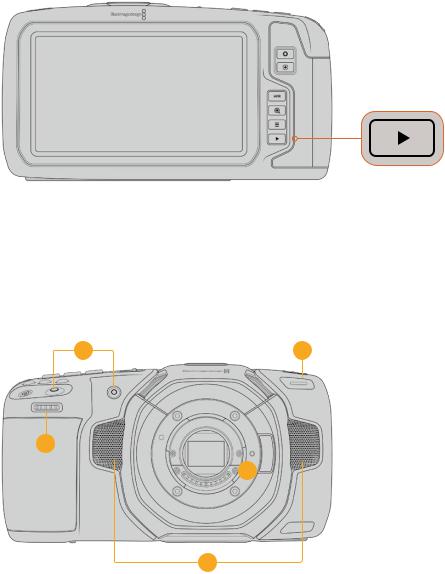
Press the forward and reverse buttons to skip to the start or end of clips. Press the reverse button once to go to the start of the current clip or press twice to skip back to the start of the previous clip. Press the record button to exit playback and return the touchscreen to the camera view.
To view your most recently recorded clip on the built in touchscreen, press the ‘play’ button on the transport controls
Camera Features
Camera Front
1 |
5 |
2
4
3
1Record Buttons
Press either of the record buttons to start and stop recording. A record button is located on the front of the camera to let you start and stop recording more easily if you are recording yourself.
2Settings Wheel
The settings wheel lets you adjust the aperture of compatible lenses mounted to your camera. With the touchscreen facing you, rotate the wheel left to open the iris, and right to close. The settings wheel is also used to adjust white balance, shutter angle and ISO settings. Press the corresponding buttons on the top of the camera, then make your selection by rotating the settings wheel. After making your selection, press the settings wheel to quickly dismiss the selection menu.
3Stereo Microphones
There are four built in, high quality stereo microphones. Refer to the ‘audio settings’ section for information on microphone audio settings.
Camera Features |
27 |
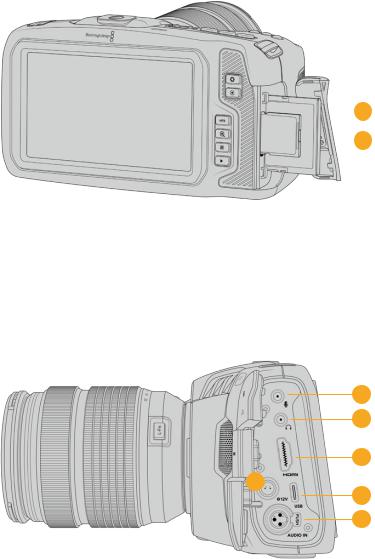
4Lens Mount
Blackmagic Pocket Cinema Camera 6K has an active EF lens mount and the 4K model has an active Micro Four Thirds lens mount. This means that you can use lenses with built-in stabilization on both cameras, as well as use auto focus and auto exposure with compatible lenses. To use the image stabilizer or ‘IS’ feature found in many active lenses, set the stabilizer switch to ‘on’ to enable image stabilization on your camera. If your lens also features a stabilizer mode switch, set it to the appropriate mode for still shots or for movement. If your lens does not have a physical stabilizer switch, you can turn ‘image stabilization’ on or off in your camera’s setup menu.
5Tally / Record Indicator
Your camera has a small LED on the front of the camera that illuminates red to indicate that the camera is recording. You can enable or disable the tally light indicator, and adjust its brightness in the setup menu. See the ‘setup settings’ section for
more information.
Right Side
 6
6
 7
7
6CFast Card Slot
Insert CFast 2.0 cards into the slot for record and playback. Refer to the ‘CFast Cards’ section for more information.
7SD Card Slot
Insert SD cards into the slot for record and playback. Refer to the ‘SD Cards’ section for more information.
Left Side
8
9
10
11
12
13
83.5mm Microphone Input
Connect a microphone to your camera’s 3.5mm stereo connector. Mic and line level audio are supported. The microphone level audio is lower than the line level, so if you are connecting a microphone to the camera and have line level selected, you will find
Camera Features |
28 |

the levels are too low. The microphone input also accepts SMPTE compliant LTC timecode from an external source on the left channel. Valid timecode will be detected automatically, and embedded in your video file as timecode metadata.
We recommend sending LTC timecode via a line level output, especially if you are not recording timecode as an audio track.
9Headphones Input
Monitor audio while recording or playing back clips by plugging your headphones into the 3.5mm stereo headphones jack. When headphones are plugged in, the speaker output is muted.
10HDMI Out
The full size HDMI connector supports 10-bit 4:2:2 1080p HD video with support for HDR and two channels of embedded audio. Use the touchscreen menu to set a clean feed or include overlays on the output.
11Power Input
You can use the DC jack to power your camera and trickle charge the battery at the same time. To connect the power adapter, rotate the plug so it aligns with the recess at the top of the jack, then push in the plug until it locks. To disconnect the power plug, retract the locking sheath, then pull out the plug.
Custom Power Solutions
Some customers have been creating custom made power devices as a means to power their Blackmagic Pocket Cinema Camera. If you are creating your own power solution with a dummy battery, caution needs to be taken to make sure you are not supplying too much voltage to your camera, as this can cause permanent damage. The voltage requirements of the Pocket Cinema Camera are as follows:
The battery input connection is rated from 6.2V to 10V max.The DC input is rated from 10.8V to 20V max.
The camera requires 16W when in standby and is not charging the battery.The camera requires 30W when charging the LP-E6 type battery.
When powering your camera with a custom made power source, we recommend removing the LP-E6 type battery.
When recording to external media with an active lens, full screen brightness, full tally brightness, high frame rates and not charging the battery,
Pocket Cinema Camera 6K requires 25W and Pocket Cinema Camera 4K requires 22W.
12USB
The USB-C port lets you record directly to an attached USB-C flash disk. When your camera is switched off, you can recharge its battery via the USB-C port from an external source such as a battery pack. To update your camera’s internal software, connect the camera to a computer via the USB-C port and run the camera update application.
13Mini XLR Microphone Input
Plug in external balanced analog audio via the mini XLR connector. A standard XLR microphone can be connected to your camera using an XLR to mini XLR adapter cable.
The mini XLR input provides phantom power for connecting professional microphones that aren’t internally powered. For more information on enabling phantom power refer to the ‘audio’ section in this manual.
Camera Features |
29 |
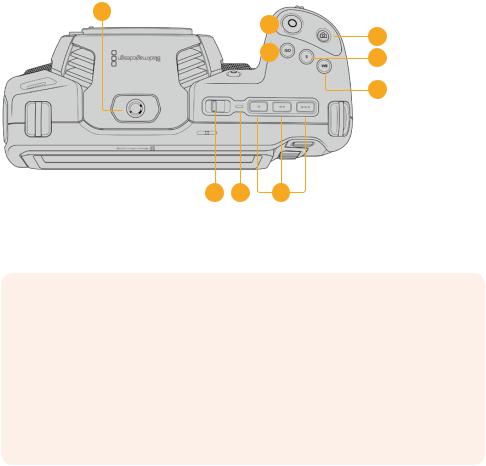
Top Panel
14
15
16
17 |
18 |
|
|
|
19 |
20 |
21 |
22 |
141/4-20 Mounting Point
You can use the 1/4-20 mounting point on the top of your camera to attach an external microphone or other small accessories.
NOTE The 1/4” mount on the top of the Pocket Cinema Camera should only be used for lightweight accessories such as small microphones. Do not support the weight of the camera via the top 1/4” mount by using accessories like a screw in camera handle in conjunction with a heavy lens. This will damage the 1/4” mount which will not be covered under warranty. Do not subject the mount to excessive lever force, such as mounting a heavy accessory on an extension arm. To mount heavier accessories, we strongly recommend using a camera cage designed for the Pocket Cinema Camera that attaches to both the top and bottom 1/4” mount simultaneously.
15Record
Press the record button to begin recording immediately. Press again to stop recording.
16Still
To capture a single uncompressed DNG frame, press the ‘still’ button. A camera icon appears briefly in the top right corner of the touchscreen display to let you know you have successfully captured a still. Image files are saved to the ‘stills’ folder in the root directory of the media you are currently recording to. These follow the file naming convention for video clips but the filename has ‘S001’ representing the ‘still number’ as the last four characters of the filename.
17ISO
Press the ISO button and then rotate the settings wheel to adjust your camera’s ISO setting. ISO can be set at 1/3 stop increments between 100 and 25,600.
18Shutter
To change the shutter angle or shutter speed, press the shutter button, then rotate the settings wheel. The touchscreen display will also suggest up to three flicker free shutter options.
19White Balance
Press the white balance button and then rotate the settings wheel to adjust your camera’s white balance. You can also quickly enter the ‘auto white balance’ screen by holding the ‘wb’ button for 3 seconds. Your camera will overlay a white square in
the center of your image, and use this area to perform an auto white balance. For more information refer to the ‘touchscreen controls’ section.
Camera Features |
30 |
